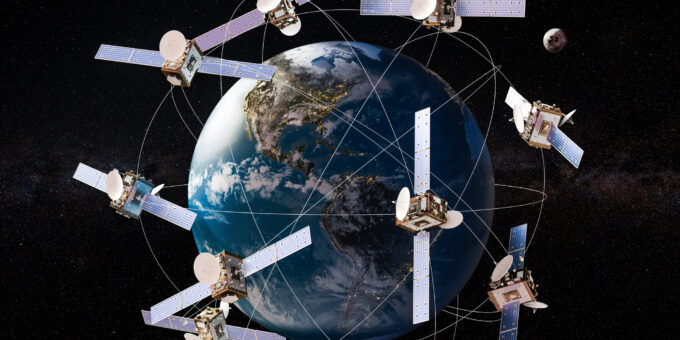
It’s still theoretically possible that Amazon will meet its deadlines and offer internet service from space by 2026. But just barely.

Image source: Getty Images.
After years of delays, in October 2023 Amazon (AMZN -0.34%) took its first step toward offering its very own satellite internet service. Competing with SpaceX’s Starlink, Amazon launched a pair of prototype Kuipersats to orbit to begin trials. Last month, the company announced its next step in the process and…
Surprise! It’s going to be another delay.
An-ti-ci-pation, Amazon’s making us wait
Late last year, shortly after launching its test satellites, Amazon boasted it would begin launching operational satellites in the first half of 2024, and then quickly open up the service to beta users this same year. Now, that already was a pretty ambitious target. As I pointed out at the time, SpaceX itself needed 15 months of testing its prototype Starlinks before shifting into mass production — and then needed 17 more months to build and launch enough satellites to be able to begin offering beta service.
That’s 32 months total, versus Amazon promising beta service roughly a year after starting testing.
And now, Amazon has hit a new bump in the space road. Those satellite launches that were supposed to begin in early 2024? They haven’t happened yet. And as SpaceNews reported last month, Amazon has now postponed delivery of its first batch of operational Kuipersats to later this summer, and postponed any launches until sometime in late 2024.
New timetable?
Precisely when Amazon will begin launching its Project Kuiper satellites isn’t yet known — and Amazon isn’t telling. NextSpaceFlight.com, though, currently has four Kuiper missions penciled in for indeterminate dates in Q4 2024 — two launches using ABL Space Systems RS1 rockets (which have never flown before), one using a Blue Origin New Glenn rocket (eight years under development, and also hasn’t ever flown), and one with a United Launch Alliance Atlas V (the most reliable option).
Subsequent to that, Amazon has three launches scheduled for Q2 2025 (all using SpaceX Falcon 9 rockets)… but curiously, zero launches scheduled for Q1 2025!
This could be a problem for two reasons.
First and most obviously, because Amazon can’t realistically begin a beta launch of its Kuiper internet service until it has a substantial number of satellites in orbit. How many satellites Amazon needs is unknown. SpaceX, for example, put 1,000 satellites in orbit before announcing its own “beta.” But it’s unclear how many launches Amazon will need to hit a similar mark.
For what it’s worth, Amazon says each rocket launch will carry “dozens” of satellites. But even assuming payload sizes similar to SpaceX’s Starlink flights (which carried about 50 satellites per launch initially), this implies Amazon may be as many as 20 rocket launches away from its own “beta.” The four launches scheduled for later this year probably won’t do the trick.
Amazon’s clock is ticking
Nor is this Amazon’s only problem. Amazon says Project Kuiper needs a total of 3,236 satellites to be complete, and based on that number, the Federal Communications Commission issued the company a license conditioned on its putting at least half those satellites — roughly 1,600 — in orbit by July 2026. Although Amazon has done a good job lining up carriers to accomplish the task — 92 separate launches scheduled to take place over a five-year timespan — it’s July 2024 already.
Now, Amazon has just two years remaining in which to get half of these five years’ worth of launches done.
And it hasn’t even started yet.
The one thing that’s going right for Amazon’s Project Kuiper
So all that’s the bad news. But there is some good news for Amazon and its space internet ambitions.
In a statement on its About Amazon blog last month, Amazon boasted that it’s “accelerating satellite production and testing” at its new 172,000-square-foot factory in Kirkland, Washington. Encouragingly, the company said the factory will eventually be producing five satellites per day. Assuming around the clock production, this implies the factory should be able to churn out more than 1,800 satellites per year, and in fact produce all 3,236 satellites needed to build Project Kuiper in under two years.
Ultimately, this lends some credence to Amazon’s assertion that “we remain on track to begin offering service to customers next year.” The satellites will be ready. The only question now is how fast Amazon’s space contractors can launch them — and how flexible the FCC will be about changing the conditions of Amazon’s license when it (probably) misses its deadline.
John Mackey, former CEO of Whole Foods Market, an Amazon subsidiary, is a member of The Motley Fool’s board of directors. Rich Smith has no position in any of the stocks mentioned. The Motley Fool has positions in and recommends Amazon. The Motley Fool has a disclosure policy.
Amazon Putting Pieces in Place to Offer Satellite Internet Service #Amazon #Putting #Pieces #Place #Offer #Satellite #Internet #Service

Source Link: https://www.fool.com/investing/2024/07/20/amazon-putting-pieces-in-place-to-offer-internet/
It’s ease theoretically doable that Amazon module foregather its deadlines and substance internet assist from expanse by…
It’s still theoretically possible that A… – BLOGGER – WP2, Amazon, internet, Offer, pieces, Place, Putting, satellite, Service